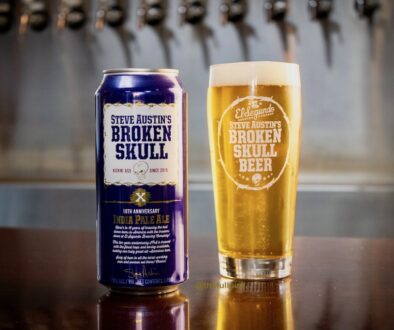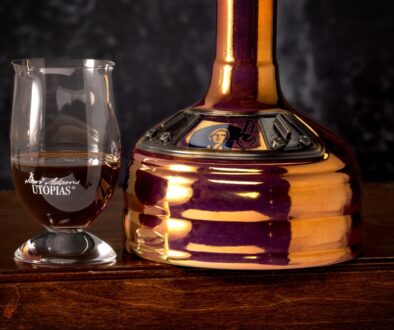Monk’s Uncle Tripel Ale Released As A Year ‘Round Offering From Pike Brewing
 Pike Brewing Releases Monk’s Uncle Tripel Ale as a year ’round offering. Pike Tandem Double Ale is reformulated with Belgian ale yeast.
Pike Brewing Releases Monk’s Uncle Tripel Ale as a year ’round offering. Pike Tandem Double Ale is reformulated with Belgian ale yeast.
There once was a little boy. He didn’t want to be a racecar driver, a cowboy or a fireman.When he grew up he wanted to be a monk. Not just any monk, but one who brewed beer. He expressed his ambition to his parents. “But son, we’re Jewish!” they told him. He became an artist instead. Being Jewish didn’t stop Charles Finkel from introducing Orval Trappist Ale into the USA years later.
When the Abbot of this famous monastery brewery, established in 1028, was told that the best importer had been identified to distribute their beer, he was also told that the principal was Jewish. “So was our lord,” the Abbot was reported to say, and Finkel got the exclusive U.S. agency. Among beer connoisseurs Orval, like the five other Trappist beers in Belgium, is regarded to this day as “holy beer.”
Miracle of miracles, the cultivation of barley and the beer brewed from it was imported from the Middle East to the West by the crusaders who introduced the new concept to the Roman Catholic Church. While it is the monks who get the credit, it was the nuns who did the brewing. Hildegard Von Bingen, the Abbess of the Convent of Bingen in Northern Germany, is credited with introducing humulus lupulus (hops) to beer around 1067AD.
Europe’s first big businesses were three breweries owned by the Monastery of St. Gall in Switzerland during the dark ages. At a time when most people were illiterate, the monasteries communicated the gravity or strength of their beers with crucifixes. One cross was for a single, a brew to be drunk on a daily basis; two crosses, a double, for special occasions; and three, a triple, reserved for religious holidays. As people learned to read and write, the cross became Xs. Multiple Xs on a bottle, still to this day, indicates a strong drink. Secular brewing got its start in the Middle Ages when people began to move to cities; many of today’s breweries trace their origin to the church. Seven monastic breweries continue to operate in Belgium and Holland.
Beers of the double and tripel style are made by monasteries today including Westmalle and Rochefort. They are the benchmarks for these distinctive styles, though many more doubles and triples are brewed in Belgium by secular breweries who, prevented by law from calling these old fashioned beers “Trappist,” call them Abbey Ales.
In 1989, Charles and Rose Ann founded the Pike Place Brewery in Seattle’s famous public market. In 1996, the company, now called The Pike Brewing Company, expanded to its current space – a gravity flow steam brewery and pub, one-half block uphill from its original location. Michael Jackson described the new Pike as, “a shrine to beer.” The Finkels sold Pike, along with Merchant Du Vin, their beer importing company in 1997. After an eight-year “sabbatical,” they re-acquired Pike in 2006 and since that time, have worked to realize their dream to own a world class brewery. Pike’s original line of beers was already well established and all were brewed with yeast originally imported from England. Remembering his childhood dream to be a monk, Charles wanted to add completely different tastes for Pike customers: a double and tripel in the monastic style. Since Charles and Rose Ann were tandem bicycle enthusiasts, they named their new Double, “Pike Tandem.” In the Abbey style, Head Brewer Drew Cluley added organic sugar and coriander to a gold medal winning brown ale.
Monk’s Uncle Triple, brewed as a spring seasonal, became the first Pike beer to use Belgium yeast. Introduced at Brouwer’s Cafe in Seattle, it became a cult classic, selling out at each release. Monk’s Uncle won the NW Brewing News Readers Choice award for “Best Belgian Ale” 2008. With the addition of more fermentation tanks to expand the brewery’s capacity, the decision was made to add Pike Monk’s Uncle Triple to the Pike lineup of beers brewed year round. Since the yeast, a strain from Westmalle Monastery, could now be propagated from one batch to the next as the brewery has done with its English style yeast since 1989, it was decided to brew Pike Tandem with the same Belgian ale yeast as well. Pike Monk’s Uncle Triple 9% alcohol by volume is brewed with organic malt and organic sugar. It is golden, full-bodied and complex with a yeasty nose, fruity esters and malty dryness. There are hints of honey, spice and exotic fruit that play with the senses. Pike Tandem Double is cocoa colored, smooth, round, nutty and complex with flavors of freshly baked bread. It is stylish and sensual without bitterness. In addition to hops, coriander is used as a seasoning. According to Finkel, drinking these beers is a, “religious experience!”



